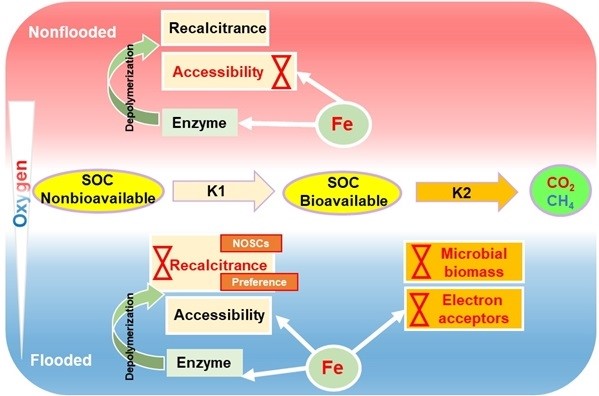Paddy soil has great potential for carbon storage, and mineralization of soil organic carbon is an important process affecting soil carbon retention.
Recently, a research team led by Prof. WU Jinshui from the Institute of Subtropical Agriculture (ISA) of the Chinese Academy of Sciences found that the regulation of "regulating valve" mechanism on organic carbon mineralization in paddy soil is determined by oxygen availability. The findings were published in Soil Biology and Biochemistry on Dec. 3.
In view of the phenomenon that the mineralization rate of soil organic matter is not controlled by microbial biomass, some scholars put forward the "regulating valve" hypothesis: the transformation of inert organic carbon to active organic carbon (K1) and the microbial utilization process of activated carbon (K2) jointly constitute the mineralization process of soil organic carbon. Since soil is a carbon-limited habitat, K1 is the rate-limiting step of organic carbon mineralization, that is, the "regulating valve".
The "regulating valve" mechanism of organic carbon mineralization has been verified in upland soil. However, whether this mechanism is applicable to paddy soil and what the "regulating valves" are in paddy soil remain unclear.
Prof. WU Jinshui's team obtained paddy soil with microbial biomass gradient through chloroform fumigation in laboratory cultivation, and set up three kinds of oxygen conditions for paddy soil in the field: aerobic anoxic alternation (dry wet alternation), anoxic (continuous flooding) and anaerobic (flooding combined with nitrogen to replace headspace air).
The results of 78-day incubation experiment showed that the availability of carbon source was the only limiting factor of organic carbon mineralization in paddy soil when oxygen was sufficient, and the "regulating valve" mechanism played a key role.
"When oxygen is limited, the role of 'regulating valve' mechanism is weakened, and microbial biomass, electron acceptor and carbon source supply jointly determine the mineralization rate of organic carbon in paddy soil," said Prof. WU.
The study enriches the internal biochemical mechanism of soil organic carbon accumulation in paddy fields from the perspective of the "regulating valve" of soil organic carbon mineralization.

Figure. 1. Conceptual model of the mechanisms of soil organic carbon mineralisation under different oxygen conditions in paddy soil (image by Li Yuhong)
Contract: Xinru Li
Tel(WeChat): 15207199553
Email: lixinru@isa.ac.cn or xrli@stimes.cn